
An analogue audio signal is conveyed as a continuously varying electrical voltage whose magnitude changes in proportion to the intensity of the original sound pressure.
The simplest kind of analogue interface, known as an unbalanced circuit, uses a single wire to convey a signal. This wire is usually surrounded by a cylindrical mesh of wire, connected to earth or ground, which acts as an electrical screen and also provides a return path for the signal itself.

Screening an unbalanced circuit doesn’t stop interference from magnetic fields, as generated by transformers, motors or other electrical devices. A low-level signal, as produced by a microphone, is particularly prone to such interference.
For this reason, most microphone connections use a balanced circuit, also known as a symmetrical circuit, employing a screened pair of wires. An electrical arrangement at the receiving end cancels out any interference signals that appear on both wires. The two wires are also wound around each other in a twisted-pair so as to minimise interference.

Balanced circuits are also used for line level signals in arduous electrical environments or where studio earthing is inadequate for high-quality audio purposes. Hence this kind of circuit is often found in the complex systems that are employed in radio and television broadcasting.
Traditionally, an audio transformer is used at both ends of a circuit to cancel out interference, although transformers can introduce transient or low frequency distortion into the signal. Modern devices often use electronic balancing or an electronically-assisted transformer.
The amount of interference rejection given by a balanced circuit is measured by its common mode rejection ratio (CMRR). This should give a figure -40 dB to -60 dB, or better.
Unfortunately, some equipment is fitted with simple differential circuits that give a poor CMRR rating. Sometimes they give a positive figure, meaning that the interference is worse than with an unbalanced circuit. In addition, some outputs drop by 6 dB when connected to unbalanced inputs. Worst of all, shorting one wire of an output to earth (which often happens when connecting to unbalanced inputs) often causes a flow of current, introducing crosstalk into other audio circuits.
Analogue devices can only generate or handle voltage levels that are within a specified range. For example, a traditional moving-coil microphone produces a signal of up to 0.1 volts (V), equal to 100 millivolts (mV). On the other hand, a domestic recording device handles voltages up to 775 mV whilst a professional tape recorder works with 3 V or more.
Each device must connect to a matching type of input, as shown in the following table:-
| Source | Peak | Input |
|---|---|---|
| Microphone | 100 mV | Mic |
| Domestic | 775 mV | Line |
| Professional | 3 V | Line |
A device connected to the wrong type of input can produce quiet or distorted sound. For example, if you connect a professional recorder to a domestic line input you’ll usually get distortion.
The wires in an audio circuit can act as an electronic device known as a capacitor, causing a reduction of high frequencies in the signal itself. Fortunately, this isn’t a problem if you’re only using short cables and where the source impedance of the output device is sufficiently low.
However, trouble can occur with long cables. For example, a typical 50 metre length of audio cable has a cable capacitance of 500 picofarads per metre (pF/m). If you use such a cable to connect a device with a source impedance of 600 ohms (Ω) to equipment with an input impedance of 10,000 Ω you’ll get a 3 dB drop at 11 kHz. The only solutions are:-
The various connectors used for audio applications are described in the following sections. Whatever the connector, its gender is determined by the shape of the contacts. Hence ‘male’ plugs have prongs, pins or poles whilst ‘female’ sockets have receptacles. A wide range of different connectors are used for audio purposes, including the types described below.
As originally used in telephone exchanges for jacking a connection onto a jackfield, jack plugs are convenient for connections that need to be changed frequently or in a hurry. The professional versions are also exceptionally robust.
An unplated plug, intended for use with a jackfield, isn’t ideal for long-term connections or for sockets designed for other kinds of plugs. A plated plug shouldn’t really be used in a jackfield, as the high contact pressure in the socket can eventually damage the plating. All types of domestic jack plugs, and most large-tip jack plugs, are supplied in plated form.
A jackfield provides a low-cost facility for setting up complex audio connections, although a computer-controlled system is often easier to use. A standard 1 unit (1 U) panel, having a height of 1.75 inches (44.45 mm), accommodates 20, 24 or 26 standard jacks or 48 miniature jacks. A jackfield built into a mixing desk usually has at least 24 mini jacks in each row.
A jackfield can be labelled using thin card, plastic, stencils, computer printing or handwriting. Typical abbreviations that you could encounter include:-
Most sockets on jackfields have inner contacts that are connected to the normal contacts whenever a plug isn’t inserted. These are usually provided at the tip and ring circuits of the jack and often have palladium or silver/palladium contacts, although a gold/silver/palladium alloy can be used for low level circuits, such as microphone signals. The jack’s ordinary contacts, which make contact with the plug itself, are known as the outer contacts. Other switch contacts can also be provided.
The inner contacts are usually used for a method of connections known as normalling. This involves connecting together jacks in pairs. Usually, this works by wiring an input jack (such as the channel input of a mixer) to an output jack (such as the output of a tape machine).
The following systems of normalling are used:-
Also known as a 2-pole quarter inch, gauge A or large-tip plug, as set by the Post Office 201 standard, this is often used for an unbalanced mono audio connection. It’s robust construction makes it popular for public address (PA) equipment.

This connector is also used for foot switch pedal connections on music synthesisers: Yamaha use a normally-closed switch whilst Roland favour a normally-open version. Some equipment only operates with the correct type of pedal, whilst other devices determine the type during boot up.
Also known as a 3-pole quarter inch, gauge A or large-tip plug, as defined by the Post Office 301 standard, this is used for stereo signals, particularly headphones, with the left-hand channel wired to the tip and the right-hand channel on the ring.
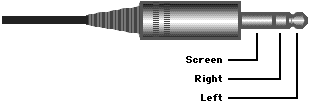
It can also be used for mono audio over a balanced circuit , with the hot wire on the tip and the cold on the ring. The volume pedal on a music synthesiser may use this connector: using the wrong type of pedal may damage your equipment.
Also known as a 3-pole quarter inch, gauge B or small-tip plug, as defined by the Post Office 316 and Trimm 90 standards. This is widely used in traditional broadcast jackfields for mono audio over a balanced circuit, with the hot wire on the tip and the cold wire on the ring. A twin version with plugs spaced at 15.875 mm is sometimes used for stereo work.

This plug doesn’t usually work properly in sockets designed for a large-tip plug. Worse still, if you insert a large-tip plug into a socket designed for a small-tip plug you can cause damage the socket’s main contacts or inner contacts.
Also known as a 3 pole 0.175 inch, Tini-Telephone or Trimm 94, this is used in miniature broadcast jackfields for mono audio over a balanced circuit. A 2 pole version may be used where unbalanced connections are considered adequate.
Also known as a 2-pole 3.5 mm jack plug and used for microphone and headphone connections on older audio equipment. It’s also used for patching signals on older analogue music synthesisers.

Also known as a 3-pole 3.5 mm jack plug and very widely used for stereo audio connections, such as the microphone and headphone circuits on personal hi-fi equipment and computers.
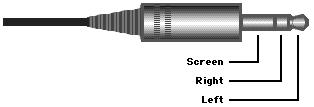
A special variation of a 3.5 mm jack plug, as used for an Apple PlainTalk microphone.

Also known as a 2-pole 2.5 mm jack plug, this is sometimes used for microphones and headphones on older equipment.
Also known as a 3-pole 2.5 mm jack plug and used for stereo circuits or special connections on very small devices.
The RCA ‘phono’ or PIN plug is also used for video or digital audio. The older long plug, with its longer centre pin, can cause problems with sockets designed for a modern short plug.

Recent connectors of this type are often gold-plated and highly reliable. Older and cheaper versions can be rather shoddy. Cables that have moulded-on connectors can be surprisingly good.
This type of plug and socket is also known as a Cannon connector, after the company that originally produced it. Being exceptionally robust, it’s used in professional equipment and is available in various pin configurations.
This connector, as illustrated below, is normally used for mono audio over a balanced circuit and is especially popular for microphones where reliability is of the utmost importance.

Normally, pins are wired in ‘XLR order’ as shown in the table below, which also lists the different terms used for each wire.
| Pin | Circuit Names |
|---|---|
| 1 | Screen |
| 2 | ▪ Line ▪ Hot ▪ Primary ▪ In-phase |
| 3 | ▪ Return ▪ Cold ▪ Secondary ▪ Out-of-phase |
Some older American equipment uses the pin 3 hot convention, in which hot and cold are swapped. This can cause problems with unbalanced devices where signals can end up shorted to earth.
Whatever wiring is used, the gender of connectors must obey the rule that plug pins point in the direction of signal. Unfortunately, some organisations, notably the BBC, sometimes treat line-level signals as if they’re carrying mains electricity, which means that audio outputs are wired to sockets.
This variation of XLR connector is less common than the 3-pin version, although it’s sometimes used for conveying balanced audio signals in two directions, with wiring as follows:-

A similar arrangement is also sometimes used for stereo connections, with the left hand channel carried on pins 2 and 3 and the right hand channel on 4 and 5. Another variant is used where a power supply is needed to accompanies a mono audio signal, as shown here:-

Strictly speaking, the Speakon isn’t an XLR connector, although it has some common characteristics. The socket, marketed by Neutrik as the NL4FC, has a non-shorting contacts and is widely used for high-level loudspeaker signals.
In appearance, these are similar to a small XLR connector, although domestic DIN connectors are far less robust. A huge number of different pin configurations are available, as well as the following types of plug locking mechanism:-
| Type | Notes |
|---|---|
| Push-pull | Compatible with |
| Latching button | Compatible with |
| Bayonet-ring | Remove ring for |
| Tuchel screw | Loose fit in |
Generally speaking, the bayonet-ring and Tuchel connectors are reserved for professional applications.
This complies with the German DIN 41524 standard for domestic audio connections, but is now rarely used for this purpose, although it’s often employed for connecting synthesisers via the Musical Instrument Digital Interface (MIDI).
The normal wiring arrangement for these plugs is as follows:-

This socket also accepts a 3-pole 180° plug, as used for older mono devices, although this only gives the left-hand channels. The pin numbering on a 3-pole connector matches that used for the 5-pole version, as shown in the diagram below:-

Pins 1 and 4 of a 5-pole connector convey a microphone level signal or diode signal (as produced by older radios), the latter having a source impedance of 1 MΩ or more. Unfortunately, non-European devices often employ domestic line level signals for the recording circuit on these pins.
The signals on pins 3 and 5 are usually at domestic line level, although these pins can also be used for connecting a phonograph (phono) pickup, more commonly known as a gramophone. Such a pickup usually produces signals that are lower than line level, requiring a special amplifier incorporating suitable equalisation.
Older devices have their phono input wired via a 3-pole 180° socket, with the left-hand channel on pin 3 and the right-hand on pin 1. Alternatively, a 5-pole socket is provided, wired as normal but with a link between pins 1 and 5, allowing equipment with a 3 or 5-pole plug to be used.
In most mono equipment the pins assigned to left and right-hand circuits are connected together, although in some instances pins 4 and 5 are simply left unconnected.
The 5-pole connector can also be used for a stereo microphone, as shown below:-
| Pin | Mic Type | Channel |
|---|---|---|
| 1 | 1 to 50 kΩ | Left |
| 2 | Screen | |
| 3 | Under 1 kΩ | Left |
| 4 | 1 to 50 kΩ | Right |
| 5 | Under 1 kΩ | Right |
or for a microphone with a balanced circuit, as shown below:-
| Pin | Circuit | Channel |
|---|---|---|
| 1 | Hot | Left |
| 2 | Screen | |
| 3 | Cold | Left |
| 4 | Hot | Right |
| 5 | Cold | Right |
A mono microphone can be wired in a similar way, but with a 3-pole 180° plug.
A microphone input in X-Y form uses one socket for both stereo connections. However, an A-B input has separate sockets for the left and right-hand microphones, each wired for mono and suitable for 3-pole plugs. The B socket may have links to pin 4 and/or pin 5 of the A socket, allowing a single-unit microphone with X-Y connections to be used in the A socket.
These are similar to a standard 5-pole 180° connector but with more contacts, which are often used for microphones that have a pause switch for remotely controlling a recording device.

Some microphones use a long reach plug. The extended body of the plug operates switches within the device, activating the remote control feature. But if a normal 5-pole plug is inserted the socket provides a normal audio connection.
An 8-pole connector, also with narrow pin spacing, is sometimes used for special applications.
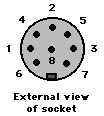
Again, similar to a standard 5-pole connector but with extra pins that have a wide spacing. This kind of connector is sometimes used for a microphone with special facilities.
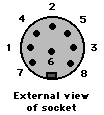
Other DIN connectors include 4-pole and 2-pole varieties (with or without a plug-actuated switch) as well as a 240° 5-pole plug and 240° 6-pole plug. The latter two types are sometimes used for remote control of slide projectors or for video cassette recorder (VCR) connections. The following arrangement is used on some older VCR machines:-
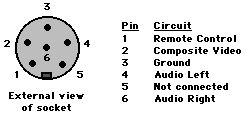
whilst later recorders that support S-Video signals sometimes employ the following connections:-

The 360° 5-pole plug, also known as a domino plug, is designed for 3 and 4-wire headphone connections. This kind of socket sometimes accommodates built-in loudspeaker switching, in some instances allowing the plug to be inserted in one of two positions, providing optional switching. The usual wiring arrangement for 4-wire headphones is shown below

The same connections are used for the ‘hot’ wires of the Left and Right circuits of 3-wire headphones, but with a common ground on pin 5. In order to accommodate both types of headphones, some outlets have pins 3, 4 and 5 wired to ground.
The 2-pole DIN 41529 connector is intended for loudspeakers. Sockets may accommodate plugs in two positions to allow automatic switching.
The smaller miniature DIN connectors aren’t often used for audio. The 3-pole version is used for Apple’s obsolete LocalTalk networking system, the 4-pole type for ADB ports on older Macs OS computers, as well as S-Video connections on home video equipment, and the 8-pole or 9-pole varieties are employed for serial ports on older Macs OS machines.
Multiway connectors are sometimes used for analogue audio, particularly with multi-track equipment, although the wiring isn’t standardised. Some plugs, because of their small size, can only be wired to thinner cables, and, although soldered connections can be used, it’s often faster to use crimped connections, even though this requires special tools.
Standard D connectors, commonly used in computer equipment, can also be used for multi-channel audio. Such plugs are shaped like an elongated letter ‘D’, with connectors available in 9, 15, 25 and 35-way versions, as well as in high-density 15 and 50-way types. The use of locking screws is vital, although some connectors have incompatible UNF or metric screws.
Amphenol connectors, of a similar shape to a D connector, have plug contacts arranged in two rows around a central projection. They come in 14, 28, 36 and 50-way versions and are fitted with rather awkward, but essential, securing latches.
Varicon connectors are far more robust, with 38 and 56-way versions in common use. The plug has a central locking screw that holds it in place.
©Ray White 2004.